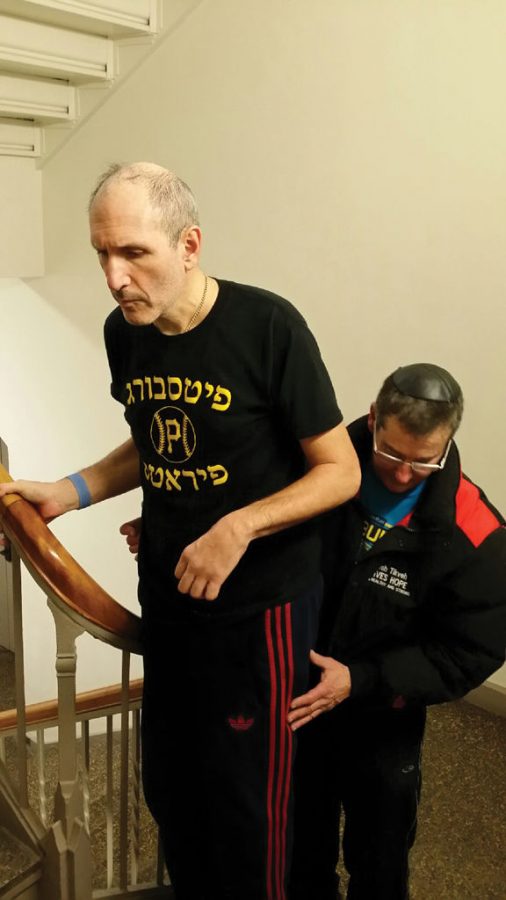Life after a stroke: Pittsburgh man regains mobility
October 21, 2014
Climbing up all 764 steps of the Cathedral of Learning seems like a difficult and physically draining prospect, but for Steve Gillis, a stroke victim determined to make a full recovery, it’s a way to prove that he can overcome challenges.
Eleven months after his stroke in January 2013, Gillis, 58, started ascending the 40 floors. Four hours after he started, Gillis was at the top. His next goal is to climb up all 94 floors of the John Hancock Center for the Hustle Up the Hancock event on Feb. 22, 2015.
“However long it takes, I’m not in any big hurry like I was at the Cathedral. I am stronger and I think I can climb up the steps in a reasonable amount of time,” Gillis said. “I’m out there to do all of it just like I’m going for 100 percent recovery of the stroke.”
Gillis suffered his stroke on Jan. 13, 2013.
“Not many people could have survived it,” Gillis said. “I was given two percent odds of survival because it severely affected the left side of my body.”
Gillis has paralysis in his left arm and leg and suffered traumatic brain damage.
“My frontal lobe was really destroyed. I was able to read and write, but my short term memory was messed up, and I had anger issues after the stroke,” Gillis said.
Gillis said he has always been a motivated and athletic person. Before the stroke, he would walk to work almost every day and enjoyed running, hiking and swimming. Last month, Gillis’ friends and family created a GoFundMe page called the Steve Gillis Hope Fund to help pay for Gillis’ expenses to Hustle Up the Hancock and his physical rehabilitation. Gillis said he has not been able to afford his physical therapy treatments in recent months and is looking for help, but he remains hopeful in his ability after the events at the Cathedral.
“The MRI would say there is no way I could’ve done what I did [at the Cathedral of Learning], but here I am talking about the [Hustle up the Hancock],” Gillis said.
Gillis’ friend, Mark Levenson, said it is inspiring to see Gillis recover from his stroke and accomplish climbing up the Cathedral steps.
“Somebody else might have given up but every day, he seems to be more and more inspired to continue and to improve,” Levenson said.
Determined to recover, Gillis attends physical therapy, does 20-minute brain exercises and reads books about quantum mechanics and Einstein’s theory of relativity every day.
He initially had problems with spatial cognition after the stroke but is improving through sessions with a therapist.
“My therapist drew a couple of figures on the paper, and I wouldn’t remember them, and I couldn’t draw lines to connect them,” Gills said. “Today I passed the test 100 percent, so that’s a good thing.”
Joseph Tersak started working with Gillis as his personal trainer after his stroke. Tersak helped him gain his balance, get out of his wheelchair and stretch his muscles.
“Anyone in that situation deserves to be a little frustrated and a little negative, and for him to be as hardworking and as optimistic as he is, despite the setbacks, is truly inspiring to me,” Tersak said.
Tersak said he wanted to help Gillis achieve his goals because Gillis’ determination to get better, in turn, also motivated him.
Gillis said his family and friends have helped him through the recovery process at every turn, and said his son was one of his biggest supporters.
Gillis can now walk around with assistance.
“I kept working toward getting stronger, more mobile, and I just never gave up,” Gillis said. “I wanted to be an inspiration for other survivors. Pretty soon, God-willing, I will be able to walk with no device.”
He suffered the stroke during his 20th year working for PNC Bank. Gillis, a consultant retail service specialist, had more awards than anybody else in the corporate headquarters and was trying to get another one. Gillis hasn’t been able to return to work after the stroke.
“I was very motivated mentally which carried over physically,” Gillis said.
Levenson accompanied Gillis on his climb up the Cathedral stairs. When Gillis switched from one flight to the next, he had to rely on the help of his friend to get him to the rail. Levenson’s job was to provide emotional support and to carry Gillis’ wheelchair up every flight.
“When we first started, after he walked two flights, it was so hard for him, at least it looked that way to me,” Levenson said. “I thought to myself for sure that maybe at the most he would make it up five or 10 flights, which would be fine, he made a great effort.”
Gillis ended up not needing the wheelchair and climbed every flight within four hours.
“If I do this [Hustle up the Hancock], I’m going to set my next goal even higher,” Gillis said. “Who knows what will be next?”



